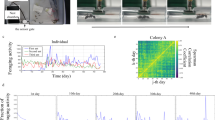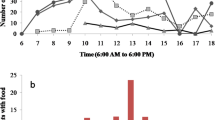Abstract
Group foraging in Myrmica rubra ants is considered as a cyclic process in which transition from one phase to another is determined by summation of actions of individual ants inside the nest and in the foraging territory. In its turn, individual behavior is considered as a labile sequence of tasks, such as territory exploration, acquiring and transportation of food, the completeness of the sequence depending on the individual experience. Data on foraging of three experimental M. rubra colonies were represented as a relational database in MS Access 2007, and the database tools were used to study the interrelated characteristics of the two levels of the foraging process (group and individual) and to analyze the quantitative parameters of individual and group behavior.
Similar content being viewed by others
References
Beckers, R., Deneubourg, J.-L., and Goss, S., “Modulation of Trail Laying in the Ant Lasius niger (Hymenoptera: Formicidae) and Its Role in the Collective Selection of a Food Source,” J. Insect Behav. 6 (6), 751–759 (1993).
Bekarevich, Yu.B. and Pushkina, N.V., MS Access 2000 in 30 Lessons (BKhV, St. Petersburg, 2000) [in Russian].
Bisseau, J.C. de, Deneubourg, J.-L., and Pasteels, J.M., “Collective Flexibility during Food Recruitment in the Ant Myrmica sabuleti (Hymenoptera: Formicidae),” Psyche 98, 323–336 (1991).
Calenbuhr, V. and Deneubourg, J.-L., “Pattern Formation via Chemical Communication: Collective and Individual Hunting Strategies,” in Biology and Evolution of Social Insects (Leuven Univ. Press, Leuven, 1992), pp. 343–349.
Detrain, C. and Deneubourg, J.-L., “Social Cues and Adaptive Foraging Strategies in Ants,” in Food Exploitation by Social Insects: Ecological, Behavioral and Theoretical Approaches (CRC Press, Boca Raton, 2009), pp. 29–52.
Dlussky, G.M., “Principles of Communication in Ants,” in N.A. Kholodkovsky Memorial Lectures, Issue 33 (Nauka, Leningrad, 1981a), pp. 3–33 [in Russian].
Dlussky, G.M., Ants of the Deserts (Nauka, Moscow, 1981b) [in Russian].
Dlussky, G.M., Voltsit, O.V., and Sulkhanov, A.V., “Group Foraging in Ants of the Genus Myrmica,” Zool. Zh. 57 (57), 65–77 (1978).
Fedoseeva, E.B., “A Technological Approach to Studying the Structure and Evolution of Insects,” Zh. Obshch. Biol. 69 (69), 264–283 (2008).
Goss, S. and Deneubourg, J.-L., “The Self-Organizing Clock Pattern of Messor pergandei (Formicidae, Myrmicinae),” Insect. Soc. 36 (36), 339–346 (1989).
Green, M.J. and Gordon, D.M., “Cuticular Hydrocarbons Inform Task Decisions,” Nature 423, 32 (2003).
Mailleux, A.-C., Detrain, C., and Deneubourg, J.-L., “Triggering and Persistence of Trail-Laying in Foragers of the Ant Lasius niger,” J. Insect Physiol. 51, 297–304 (2005).
Malyshev, S.I., Hymenoptera: Their Origin and Evolution (Sovetskaya Nauka, Moscow, 1959) [in Russian].
Markl, H. and Hölldobler, B., “Recruitment and Food-Retrieve Behavior in Novomessor (Formicidae, Hymenoptera),” Behav. Ecol. Sociobiol. 4, 183–216 (1978).
McDonald, P. and Topoff, H., “Social Control of Behavioral Development in the Ant Novomessor albisetosus (Mayr),” J. Comp. Psychol. 99, 3–14 (1985).
Mersch, D.P., Crespi, A., and Keller, L., “Tracking Individuals Shows Spatial Fidelity Is a Key Regulator of Ant Social Organization,” Science 340, 1090–1093 (2013).
Orlova, T.A., “A Laboratory Study of the Behavior of the Black Garden Ant Lasius niger,” in Methods of Ecological and Ethological Research (Pushchino, 1986), pp. 295–300 [in Russian].
Orlova, T.A., “The Behavioral Structure of Lasius niger at Early Stages of Colony Development,” in Behavior of Animals and the Principles of Self-Organization (Borok, 1994), p. 74 [in Russian].
Panait, L.A. and Luke, S., “Learning Ant Foraging Behaviors,” in Proc. of the Ninth Int. Conf. on the Simulation and Synthesis of Living Systems ALIFE9 (2004), pp. 569–574.
Pielström, S. and Roces, F., “Vibrational Communication in the Spatial Organization of Collective Digging in the Leaf-Cutting Ant Atta vollenweideri,” Animal Behav. 84, 743–752 (2012).
Prabhakar, B., Dektar, K.N., and Gordon, D.M., “The Regulation of Ant Colony Foraging Activity without Spatial Information,” Comput. Biol. 8 (8), 1–10 (2012).
Prague, C.N. and Irwin, M.R., Microsoft Access 2000 Bible (Wiley, 2003; Dialektika, Moscow, 2004) [in Russian].
Roces, F. and Hölldobler, B., “Use of Stridulation in Foraging Leaf-Cutting Ants: Mechanical Support during Cutting or Short-Range Recruitment Signal?” Behav. Ecol. Sociobiol. 39, 293–299 (1996).
Sablin-Yavorsky, A.D., “The Establishment of Lasius niger Settlements in the Process of Growth and Interactions of the Primary Microcolonies,” in Ants and Forest Protection: Proc. of X All-Russian Symp. (Peshki, Moscow, 1998), pp. 20–22.
Sudd, J.H., “The Excavation of Soil by Ants,” Z. Tierpsychol. 26 (26), 257–276 (1969).
Ugolev, A.M., Natural Technologies in Biological Systems (Nauka, Leningrad, 1987) [in Russian].
Wilson, E., “Chemical Communication among Workers of the Fire Ant Solenopsis saevissima. 1. The Organization of Mass Foraging; 2. An Information Analysis of the Odor Trail; 3. Experimental Induction of Social Responses,” Animal Behav. 10, 134–147, 148–158, 159–164 (1962).
Zakharov, A.A., Intraspecific Relations in Ants (Nauka, Moscow, 1972) [in Russian].
Zakharov, A.A. and Orlova, T.A., “Behavioral Structure and Individual Behavior in Ants,” in Behavior of Insects (Nauka, Moscow, 1984) [in Russian].
Zhantiev, R.D. and Sulkhanov, A.V., “Sounds Produced by Ants of the Genus Myrmica,” Zool. Zh. 56 (56), 1255–1258 (1977).
Author information
Authors and Affiliations
Corresponding author
Additional information
Original Russian Text © E.B. Fedoseeva, 2015, published in Zoologicheskii Zhurnal, 2015, Vol. 94, No. 10, pp. 1163–1178.
Rights and permissions
About this article
Cite this article
Fedoseeva, E.B. A technological approach to the description of group foraging in the ant Myrmica rubra . Entmol. Rev. 95, 984–999 (2015). https://doi.org/10.1134/S0013873815080060
Received:
Published:
Issue Date:
DOI: https://doi.org/10.1134/S0013873815080060




